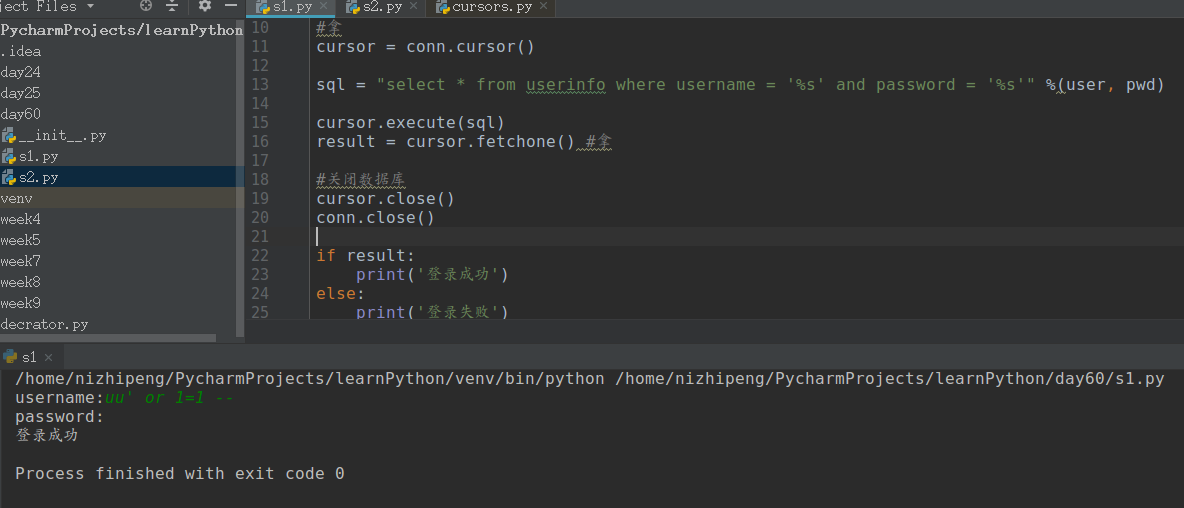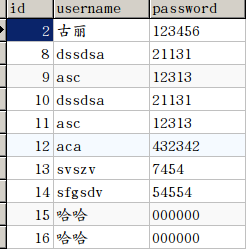day60
参考:http://www.cnblogs.com/wupeiqi/articles/5713330.html
查询(登录)s1.py
1 import pymysql 2 3 user = input("username:") 4 pwd = input("password:") 5 6 #连接数据库 7 8 #打开 9 conn = pymysql.connect(host= "localhost", user = 'root', password='112358', database = 'db4') 10 #拿 11 cursor = conn.cursor() 12 13 sql = "select * from userinfo where username = '%s' and password = '%s'" %(user, pwd) 14 # select * from userinfo where username='uu' or 1=1 -- ' and password='%s' 15 #其中 1=1百分百成立( -- )将后半部分注释 16 #uu' or 1=1 -- 17 # 倪志鹏' -- 也行 18 cursor.execute(sql) 19 result = cursor.fetchone() #拿 20 21 #关闭数据库 22 cursor.close() 23 conn.close() 24 25 if result: 26 print('登录成功') 27 else: 28 print('登录失败')

执行结果:
username:古丽 password:123456 登录成功 Process finished with exit code 0
但是以上方式存在一个问题:

不用用户名和密码也能登录。
是因为SQL注入。
sql = "select * from userinfo where username = '%s' and password = '%s'" %(user, pwd) # select * from userinfo where username='uu' or 1=1 -- ' and password='%s' #其中 1=1百分百成立( -- )将后半部分注释 #uu' or 1=1 -- # 倪志鹏' -- 也行
如果用拼接方式存在漏洞,or 1 = 1,百分百处理, -- 会将后半部分注释,所以无所谓输入的密码是什么。
应改为以下方式s2.py:
1 import pymysql 2 3 user = input("username:") 4 pwd = input("password:") 5 6 #连接数据库 7 8 #打开 9 conn = pymysql.connect(host= "localhost", user = 'root', password='112358', database = 'db4') 10 #拿 11 cursor = conn.cursor() 12 13 #不要字符串拼接 14 sql = "select * from userinfo where username = %s and password = %s" 15 16 #cursor.execute(sql, user, pwd) linux下报错 17 18 cursor.execute(sql, [user, pwd]) 19 20 result = cursor.fetchone() #拿 21 22 #关闭数据库 23 cursor.close() 24 conn.close() 25 26 if result: 27 print('登录成功') 28 else: 29 print('登录失败')
其中第16行在linux下可能出错。
执行结果
username:asc password:12313 登录成功 Process finished with exit code 0
插入 s3.py
1 import pymysql 2 3 user = "呱呱" 4 pwd = "asca" 5 6 #连接数据库 7 #打开 8 conn = pymysql.connect(host= "localhost", user = 'root', password='112358', database = 'db4') 9 #拿 10 cursor = conn.cursor() 11 #增 12 # sql = "insert into userinfo(username, password) values(%s,%s)" 13 # cursor.execute(sql,[user,pwd]) 14 15 #增加多个 16 sql = "insert into userinfo(username, password) values(%s,%s)" 17 r = cursor.executemany(sql,[('dssdsa', '21131'), ('asc', '12313')]) 18 #其中r为受影响的行数 19 conn.commit()#提交 20 21 22 #关闭数据库 23 cursor.close() 24 conn.close()
16~17为插入多对数据,其中r为受影响的行数。
19行不要忘了提交。
取fetchone、fetchmany等 s4.py
1 import pymysql 2 3 #打开 4 conn = pymysql.connect(host= "localhost", user = 'root', password='112358', database = 'db4') 5 #拿 6 cursor = conn.cursor(cursor = pymysql.cursors.DictCursor)#带其中参数,可使结果为列表带字典 7 8 sql = "select * from userinfo;" 9 10 cursor.execute(sql) 11 result = cursor.fetchone() #每次拿一个 12 print(result) 13 result = cursor.fetchone() #拿 14 print(result) 15 16 #按顺序拿 17 result = cursor.fetchmany(2) #拿 18 print(result)#元组 19 20 #关闭数据库 21 cursor.close() 22 conn.close()
按顺序拿取,其中第6行带参数,可以输出列表带字典,不带参数输出元组。
执行结果:
{'username': '古丽', 'id': 2, 'password': '123456'}
{'username': 'dssdsa', 'id': 8, 'password': '21131'}
[{'username': 'asc', 'id': 9, 'password': '12313'}, {'username': 'dssdsa', 'id': 10, 'password': '21131'}]
Process finished with exit code 0
新插入数据的自增id s5.py
1 #新插入数据的自增id 2 3 #文章表:id title hobby_count 4 # 1 assda 0 5 6 import pymysql 7 8 #连接数据库 9 #打开 10 conn = pymysql.connect(host= "localhost", user = 'root', password='112358', database = 'db4') 11 #拿 12 cursor = conn.cursor() 13 #增 14 sql = "insert into userinfo(username, password) values('哈哈','000000')" 15 cursor.execute(sql) #linux下报错 16 conn.commit()#提交 17 print(cursor.lastrowid)#输出插入语句的自增id 18 19 #关闭数据库 20 cursor.close() 21 conn.close()
第17行输出插入语句的自增id。
输出结果:
16
Process finished with exit code 0
